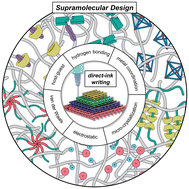Advanced supramolecular design for direct ink writing of soft materials
Abstract
The exciting advancements in 3D-printing of soft materials are changing the landscape of materials development and fabrication. Among various 3D-printers that are designed for soft materials fabrication, the direct ink writing (DIW) system is particularly attractive for chemists and materials scientists due to the mild fabrication conditions, compatibility with a wide range of organic and inorganic materials, and the ease of multi-materials 3D-printing. Inks for DIW need to possess suitable viscoelastic properties to allow for smooth extrusion and be self-supportive after printing, but molecularly facilitating 3D printability to functional materials remains nontrivial. While supramolecular binding motifs have been increasingly used for 3D-printing, these inks are largely optimized empirically for DIW. Hence, this review aims to establish a clear connection between the molecular understanding of the supramolecularly bound motifs and their viscoelastic properties at bulk. Herein, extrudable (but not self-supportive) and 3D-printable (self-supportive) polymeric materials that utilize noncovalent interactions, including hydrogen bonding, host–guest inclusion, metal–ligand coordination, micro-crystallization, and van der Waals interaction, have been discussed in detail. In particular, the rheological distinctions between extrudable and 3D-printable inks have been discussed from a supramolecular design perspective. Examples shown in this review also highlight the exciting macroscale functions amplified from the molecular design. Challenges associated with the hierarchical control and characterization of supramolecularly designed DIW inks are also outlined. The perspective of utilizing supramolecular binding motifs in soft materials DIW printing has been discussed. This review serves to connect researchers across disciplines to develop innovative solutions that connect top-down 3D-printing and bottom-up supramolecular design to accelerate the development of 3D-print soft materials for a sustainable future.

- This article is part of the themed collection: ChemSocRev – Highlights from 2023


 Please wait while we load your content...
Please wait while we load your content...
